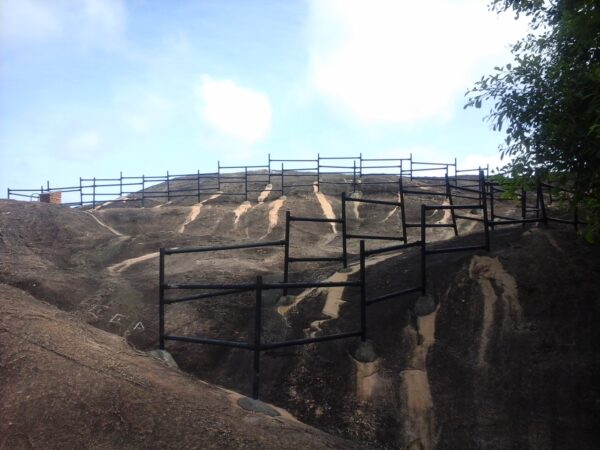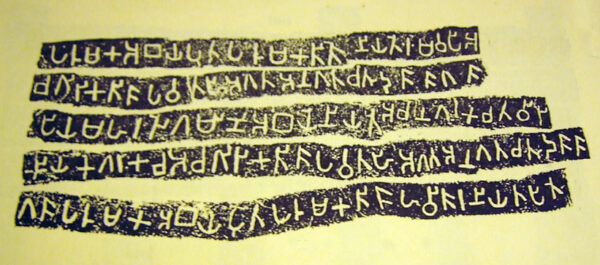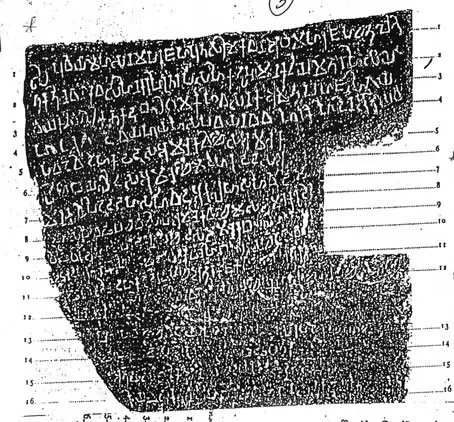Thonigala Rock Inscriptions – steeped in legend – By Arundathie Abeysinghe

 There are many places in Sri Lanka known as “Thonigala” and two locations have the same historical as well as archeological significance. One location is situated at the 6th Mile Post in *Vavuniya-*Horowpathana Road. This location is well-known due to the rock inscriptions engraved on a low flat hummock of gneiss rock, approximately two meters (eight feet) towards south of the ruins of a small rubble-built stupa (dagoba) that describes a banking system that existed in the 4th Century. Also known as Toṇigala (Thonigala) or Nagaragala, the location is situated in the jungle approximately 9.5 kilometers (6 miles) from Vavuniya, in close proximity to the border between Northern Province and North-Central Province of Sri Lanka
There are many places in Sri Lanka known as “Thonigala” and two locations have the same historical as well as archeological significance. One location is situated at the 6th Mile Post in *Vavuniya-*Horowpathana Road. This location is well-known due to the rock inscriptions engraved on a low flat hummock of gneiss rock, approximately two meters (eight feet) towards south of the ruins of a small rubble-built stupa (dagoba) that describes a banking system that existed in the 4th Century. Also known as Toṇigala (Thonigala) or Nagaragala, the location is situated in the jungle approximately 9.5 kilometers (6 miles) from Vavuniya, in close proximity to the border between Northern Province and North-Central Province of Sri Lanka
These inscriptions were recorded by Henry Parker in 1886 and they were listed in the Annual Report of the Archaeological Survey of Ceylon of 1892, yet, there were no attempts to interpret the text before *Professor Senarath Paranavitana’s edition in the early 1930s (Epigraphia Zeylanica 3, pp. 172–188).
As the inscriptions are over 1700 years old, it is hard to read them. The first inscription has been read and describes about grain distribution and considered as one of the most significant inscriptions in Sri Lanka.
According to the text, a certain minister deposited some quantities of grain and beans with a guild in the northern quarter of the city with the stipulation that the capital should remain unspent and the interest should be utilized to provide meals to resident monks of the Yahisapavata Monastery during the *“Vas” season of every year. The inscription comprises detailed instructions regarding the amount of interest that should be taken outlining different kinds of provisions to be supplied for feeding the monks.

During Sri Lanka’s protracted civil war, Thonigala Rock Inscriptions in Vavuniya had been covered with clay by the Department of Archaeology with the assistance of the security forces to safeguard the inscriptions as they could be damaged due to mortar attacks.
A few months ago, after a lapse of several years, measures had been taken to get rid of the clay cover and open the inscriptions for viewing.
The second Thonigala inscription is located in *Anamaduwa and it is 100 meters (approximately 328 feet) long with each letter approximately 30 centimeters (one foot) tall and the letters have been carved approximately two centimeters (one inch) into the rock. Dating to the era of *King Vijaya and *Kuweni and located in close proximity to Anamaduwa, approximately 300 meters away from Puttlam – Kurunegala Road, the location is easily accessible.
Considered as the largest rock inscriptions in Sri Lanka, dating to 1st century AD, these inscriptions are believed to be a description of the grants made to the Paramakanda Monastery located in close proximity. There are two large inscriptions on the rock. Surroundings of the rock with breathtaking vistas of nature and a *wewa in the backdrop add charm to the location.
According to archaeologists, these inscriptions date to the era of King Mahaculi Mahathissa (76-62 BC), son of King Wattagamini Abaya (also known as King Walagamba). The inscriptions describe grants made to Paramakanda Monastery located on another rock formation in close proximity to the inscriptions. These inscriptions are considered significant as they reveal the origin of Sinhala letters. Although, there is a steel fence erected by the Department of Archaeology, it is corroded and the cement that was utilized to fix the fence to the rock has discolored the inscriptions.
The rock is entwined in folklore and is considered as the homeland of Kuweni, the queen of the Demon Tribe. When King Vijaya chased away Kuweni, she has fled to her ancestral home and cursed King Vijaya from the summit of Lathonigala (literally meaning lamenting rock), a rock located in close proximity to Thonigala. According to folklore, Kuweni has left her two children at the rock and has come to the ancestral village alone, whereupon her tribe killed her for her betrayal of the clan. Thereafter, her children fled to the jungle. *Veddas are considered as direct descendants of these children. There is another folklore that Kuweni committed subside by jumping off Lathonigala.

Image courtesy – uncommon-paths.blogspot.com & Wikipedia.com
- Anamaduwa – A town in Puttalam District of North Western Province, Sri Lanka located approximately 28 kilometers away from Puttalam.
- Enlightenment – In Buddhism, Enlightenment is when a Buddhist finds the truth about life and stops being reborn as he/she has reached *Nirvana.
- Horowpathana – Situated in North Central region of Sri Lanka, 52 kilometers away from Anuradapura town. Horowpathana Elephant Holding Ground (EHG) is the world’s first EHG (to retain rogue elephants) spread within an area of 997 hectares. Many elephants from all parts of Sri Lanka have been translocated to Horowpathana EHG.
- King Vijaya – According to the *Mahawamsa chronicle, Prince Vijaya was the first Sinhalese King. According to legends, he and several hundred followers came to Sri Lanka after they were banished from Singur, India.
- Kuweni – Also known as “Sesapathi” or “Kuwanna” was a queen of the Yaksha tribe (considered as aboriginal tribes of Sri Lanka) described in the ancient Pali chronicle *Mahawamsa.
- Mahawamsa – “Great Chronicle” or “Great Dynasty” (in Sinhala) is the most significant work of Sri Lankan origin written in Pali Language. The Chronicle describes life and times of Sri Lankans from the arrival of Vijaya in 43 BC to the reign of King Mahasena from sixth century BC to fourth century AD. Culawamsa (lesser chronicle) covers the period from fourth century AD to British takeover of Sri Lanka in 1815. Mahawamsa consists of three parts covering a historical record of over two millennia. It is considered as the world’s longest unbroken historical record.
- Nirvana – Refers to a release from the cycle of death and rebirth, the ultimate spiritual goal of Buddhism.
- Professor Senarath Paranavitana (1896 – 1972) – Pioneering archeologist and renowned epigraphist of Sri Lanka, his works dominated Sri Lankan archaeology as well as history during the middle-part of the 20th century. In 1940, he assumed duties as the Commissioner of Archaeology.
- “Vas” season – The Buddhist monastic retreat observed primarily in Buddhist communities in Asia during the three-month monsoon period each year. During the “Vas” season, monks who ordinarily are mendicant wanderers gather in monasteries during the rainy season for a period of study and religious discourse when traveling was difficult. Residing in their retreat during the rainy season, they would pursue their meditative quest. The practice was well-known in India during the period of the Buddha (6th century BCE, after his *Enlightenment). The Buddha has also spent the rainy season in a sheltered location in the forest near Banaras (Varanasi).
- Vavuniya – Located in the north of Sri Lanka in the Northern Province, Vavuniya District has an area of 1,967 square kilometers. Vavuniya is the main settlement in the Vavuniya District. The Security Forces Headquarters “Wanni” is also located in Vavuniya.
- Veddas – Also spelled “Veddah” and known as “Wanniyalaeto”, are a minority indigenous group of people in Sri Lanka. Considered as Sri Lanka’s aboriginal inhabitants prior to the 6th century bce, according to historical records, they were the children or descendants of Queen Kuweni of Yaksha tribe (wife of Sri Lanka’s legendary first King Vijaya – 5th BC). According to anthropologists, Veddas date to the stone age. Predominantly, hunter-gather people, Veddas have been living harmoniously with nature.
- “Wewa” – Considered as an ingenious masterpiece, hitherto unknown to other parts of the world, it is a unique ‘water conservation system’, consisting of a diverse network of over 30,000 “Wewu” (plural of “Wewa”) spread across dry land.







